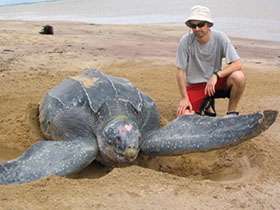Deakin researcher calls for citizen scientists to help save rare 500kg turtle

A Deakin University marine scientist is asking coastal Victorian and Tasmanian locals and summer holidaymakers to help save one of the ocean's biggest yet most elusive endangered creatures.
Professor Graeme Hays has taken the unusual step of calling on the public to join his research team, simply by keeping their eyes open and letting him know when they are lucky enough to see the Leatherback turtle, which also holidays each year along southern Australia's coastline.
"Unfortunately though, unlike the growing number of human tourists in this beautiful part of the world, the giant Leatherback turtle, which can weigh up to 500kg, is declining in numbers each year," Professor Hays said.
"We suspect this is because they drown after inadvertently becoming caught in fishing nets, but I am very keen to find hard evidence; what is happening to these beautiful creatures when they swim in our waters? I can't do that when I don't know exactly where they are.
"Records show there are only around 5000 of these turtles in the Western Pacific region, from our coast to Papua New Guinea, where they breed before coming our way," Professor Hays said.
"You compare that to the Flatback or Green turtles, of which there are literally hundreds of thousands and it's like imagining the entire human population was just the number of people left in Terang.
"I could look wherever I am for literally years and find only three, but if we have many people looking right across the Victorian and Tasmanian coastline then our chances of finding them improve drastically.
Professor Hays, a member of Deakin's Centre for Integrative Ecology, said the Leatherback turtle spent much of the year in the warm waters surrounding Papua New Guinea before heading south to Australia, but unlike most other breeds of turtles, they shunned the waters of the Great Barrier Reef, in favour of our colder coastline.
"The occurrence of high numbers of Leatherback turtles in southern Australian waters has only recently come to light through a combination of satellite tracking and a detailed compilation of direct observations of turtles that have been made over the last 125 years," he said.
"Unfortunately many of these direct observations are of dead turtles that have drowned after being entangled in fishing gear.
"Australia has national and international obligations to protect endangered species that migrate widely, as we are a signatory to the Convention of Migratory Species and the Indian Ocean - South East Asian Marine Turtle MoU.
"The EPBC Act also lists the Leatherback turtle as an endangered species and actions to reduce threats are included in the Australian Government's Marine Turtle Recovery Plan."
Professor Hays said that although bycatch mitigation and mandatory catch reporting occurs in some Australian fisheries, there is no concerted work to identify how turtle deaths might be reduced.
"This knowledge gap is alarming, because while the occurrence of Leatherback turtles in Australian waters has now been highlighted, they could very quickly be gone tomorrow if high levels of bycatch continue.
"We know that these giant turtles come to Australian waters regularly, but we still know little about exactly where and when they feed, and where their chances of being killed are highest.
"Answers to these questions may be possible through expansive citizen science projects – where members of the public report observations.
"If people know what to look out for when they are on the coast or at sea, and know how to report their observations then this information can fill significant information gaps."
Professor Hays said information on how to identify leatherbacks turtles, maps of where they have been sighted previously and details of how to report new observations were available at cie-deakin.com/about-sast/ as part of Deakin's Southern Australian Sea Turtle project.
So next time you visit the southern Australia coast keep an eye open for the largest sea turtle in the world.
Provided by Deakin University


















